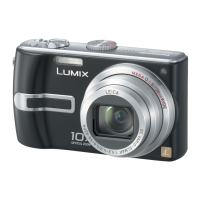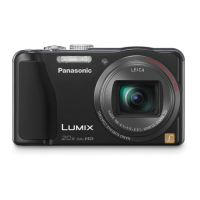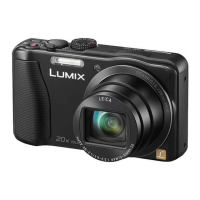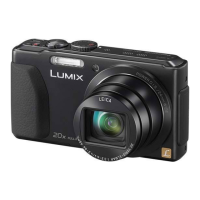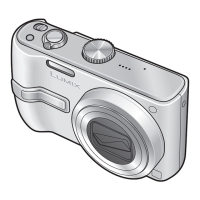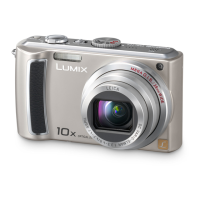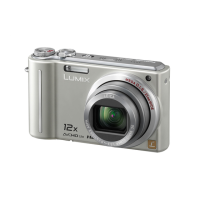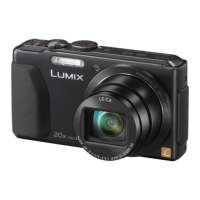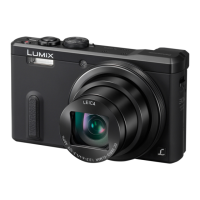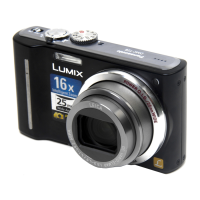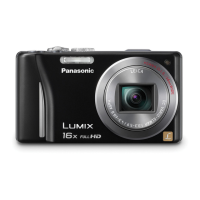
Do you have a question about the Panasonic Lumix DMC-TZ31 and is the answer not in the manual?
| Megapixel | 14.1 MP |
|---|---|
| Camera type | Bridge camera |
| Sensor type | Live MOS |
| Image stabilizer | Yes |
| Total megapixels | 15.3 MP |
| Image sensor size | 1/2.33 \ |
| Supported aspect ratios | 3:2, 4:3, 16:9 |
| Maximum image resolution | 4320 x 3240 pixels |
| Still image resolution(s) | 3232 x 3232, 4320 x 2432, 4320 x 2880, 4320 x 3240 |
| Digital zoom | 4 x |
| Optical zoom | 20 x |
| Focal length range | 4.3 - 86 mm |
| Maximum aperture number | 6.4 |
| Minimum aperture number | 3.3 |
| Lens structure (elements/groups) | 12/10 |
| Maximum focal length (35mm film equiv) | 560 mm |
| Minimum focal length (35mm film equiv) | 24 mm |
| Normal focusing range | 0.5 - ∞ m |
| Auto focusing (AF) modes | Spot Auto Focus |
| Macro focusing range (tele) | 1 - ∞ m |
| Macro focusing range (wide) | 0.03 - ∞ m |
| Normal focusing range (tele) | 2 - ∞ m |
| ISO sensitivity | 100, 200, 400, 800, 1600, 3200, 6400 |
| Light exposure modes | Auto, Manual |
| Light exposure correction | ± 2EV (1/3EV step) |
| Fastest camera shutter speed | 1/2000 s |
| Slowest camera shutter speed | 15 s |
| Flash modes | Auto, Pre-flash, Red-eye reduction |
| Flash range (tele) | 1 - 3.3 m |
| Flash range (wide) | 0.6 - 6.4 m |
| Power source type | Battery |
| Scene modes | Close-up (macro), Night, Night landscape, Panorama, Portrait, Sports, Sunset, Underwater, Landscape (scenery) |
| Photo effects | Black&White, Sepia, Skin tones |
| White balance | Auto, Cloudy, Daylight, Lamp, Manual |
| Self-timer delay | 2, 10 s |
| Camera file system | DCF 2.0, Exif 2.3 |
| On Screen Display (OSD) languages | CZE, DAN, DEU, DUT, ENG, ESP, FIN, FRE, GRE, HUN, ITA, JPN, POL, POR, SWE, TUR |
| Video resolutions | 320 x 240, 640 x 480, 1280 x 720, 1920 x 1080 pixels |
| Video formats supported | AVCHD, M-JPEG, MP4 |
| Maximum video resolution | 1920 x 1080 pixels |
| Internal memory | 12 MB |
| Compatible memory cards | SD, SDHC, SDXC |
| Field of view | 100 % |
| Display diagonal | 3 \ |
| Display resolution (numeric) | 460000 pixels |
| USB version | 2.0 |
| Product color | Black |
| Battery voltage | 3.6 V |
| Battery capacity | 895 mAh |
| Battery life (CIPA standard) | 260 shots |
| Cables included | USB |
| Bundled software | Adobe Reader PHOTOfunSTUDIO 8.1 Premium Edition Lumix Foto Uploader |
| Depth | 28 mm |
|---|---|
| Width | 105 mm |
| Height | 59 mm |
| Weight | 184 g |
| Weight (including battery) | 206 g |
General advice on handling the camera to prevent damage and ensure proper function.
Explains how condensation forms and how to resolve it to protect camera components.
Essential advice before operating the camera, including testing and copyright observance.
Notes that illustrations and operations may vary between camera models like DMC-TZ30/TZ31/TZ27.
Details on how the camera records and uses location data via GPS satellites.
Explains the steps and conditions for acquiring satellite signals and determining location.
Advisories on using the GPS function in different countries and regions.
Identifies and describes the main external components and buttons of the camera.
Details the LCD screen display elements and key control buttons like DISP. and Q.MENU.
Explains the specific actions assigned to each direction of the cursor button.
Describes how to interact with the camera using touch gestures like touch and drag.
Information on using genuine batteries and warnings about counterfeit products.
Step-by-step instructions for correctly inserting and removing the camera battery.
Methods for charging the battery using an AC adapter or computer.
Explains the charging lamp signals and estimates charging duration.
Guidelines for the number of pictures and recording time based on battery life.
Details on using memory cards and the camera's internal storage for saving pictures.
How to check the remaining capacity for pictures and recording time.
Tables showing picture and video capacity based on card size and settings.
Step-by-step guide for setting the camera's clock for the first time.
Instructions for modifying the clock and date after initial setup.
Steps for turning the camera on and selecting shooting modes.
Guidance on aiming, shooting, and proper camera grip techniques.
Steps for reviewing photos and turning off the camera.
Using Program AE mode for creative control over settings.
Method for focusing on subjects not in the center of the frame.
Using the touch screen to focus and take pictures instantly.
Adjusting focus and exposure by touching the screen subject.
Using the Intelligent Auto mode for automatic scene optimization.
Camera's automatic scene recognition and backlight correction features.
Motion Deblur for reducing blur and i.Handheld Nite Shot for low-light handheld shots.
Capturing scenes with high contrast for balanced exposure and detail.
Maintaining focus on moving subjects using touch or cursor controls.
Explains which settings are fixed or unavailable in Intelligent Auto mode.
Basic steps to record and stop motion pictures.
Explains AVCHD and MP4 formats and their compatibility.
Recording video in Program AE and Aperture Priority modes.
Notes on recording motion pictures in various other shooting modes.
Important considerations for temperature, battery, and available functions during video recording.
Taking still pictures without interrupting motion picture recording.
Using burst mode to capture multiple stills while recording video.
Standard method for viewing still pictures sequentially.
Magnifying pictures and viewing multiple images at once.
Browsing pictures by selecting dates from a calendar.
How to select and play video files, and controls during playback.
Detailed explanation of playback operations and important considerations.
Saving individual frames from motion pictures as still images.
Dividing a single motion picture into two parts.
Step-by-step process for deleting one picture at a time.
Options for deleting multiple selected pictures or all pictures.
Overview of the different menu categories available in various modes.
General steps for accessing and changing settings via the menu.
Quickly accessing and adjusting frequently used menu items.
Configuring time, date, world time, and travel dates.
Adjusting volume, custom settings, and LCD brightness/mode.
Guide lines, histogram, video area display, and zoom position memory.
Settings for battery conservation and automatic picture review.
Resetting file numbers, camera settings, and USB connection options.
Configuring video output, VIERA Link control, and 3D display settings.
Automatic picture rotation and memory card formatting procedures.
Setting the display language and using the demonstration mode.
How to change the information shown on the LCD during recording.
How to change the information shown on the LCD during playback.
Explanation of the histogram for analyzing picture brightness distribution.
How to zoom in and out using the zoom lever.
Using the touch screen to operate the zoom function.
Explains optical, extra optical, i.ZOOM, and digital zoom types.
Selecting and using different flash modes like Auto, Red-Eye, and Forced Flash.
Details on which modes support flash and the effective flash range.
Using AF Macro mode for photographing subjects at very close distances.
Utilizing Macro Zoom for magnified close-up shots.
Setting and using the self-timer for delayed shots.
Manually adjusting exposure to correct brightness issues.
Automatically taking multiple shots with varying exposure.
Controlling aperture while shutter speed is automatic.
Controlling shutter speed while aperture is automatic.
Full manual control over aperture and shutter speed.
Applying artistic effects to pictures using Creative Control mode.
Steps to change creative effects and record motion pictures with them.
Overview of how to select and use predefined scene modes.
Descriptions for Portrait, Soft Skin, and Scenery scene modes.
Capturing wide panoramic images by stitching multiple shots.
Using modes for sports, night portraits, and night scenes.
HDR, Food, Baby, and Pet scene modes for specific subjects.
Sunset, High Sensitivity, Glass Through, and Underwater scene modes.
Recording video at high frame rates for slow-motion playback.
Instructions for capturing 3D still images by moving the camera.
Saving camera settings to memory slots for quick recall.
Applying saved custom settings via the mode dial.
Options for continuous shooting speed and number of pictures.
How aspect ratio affects burst photography and limitations.
How the camera identifies and tracks faces for focus and exposure.
Step-by-step process to add facial data and names.
Managing registered faces and their associated information.
Recording travel dates and locations associated with pictures.
Adjusting the camera's clock for different time zones during travel.
How to input text for names, locations, and titles using the camera controls.
Setting the image's aspect ratio and resolution.
Adjusting image quality and ISO sensitivity.
Correcting color balance under different lighting conditions.
Selecting AF modes like Face Detection, Tracking, and Spot focusing.
Enabling continuous autofocus and the AF assist lamp.
Adjusting light metering and automatic contrast/exposure.
Controlling minimum shutter speed, resolution enhancement, and digital zoom.
Burst shooting settings, color effects, and AF assist lamp options.
Features for reducing red-eye and stabilizing images.
Adding date/time stamps and configuring the clock.
Selecting video format (AVCHD/MP4) and recording quality.
Settings for continuous autofocus and wind noise reduction during video recording.
How to display and navigate through photos taken in burst mode.
Notes on grouping, editing, and compatibility issues for burst playback.
Overview of different ways to view pictures and videos.
Setting up automatic picture slideshows with effects and music.
Narrowing down pictures by category or date for viewing.
Using automatic tools to enhance picture color and brightness.
Applying artistic filters and effects to photos.
Preparing pictures for uploading to websites like Facebook or YouTube.
Adding text titles and modifying GPS location information.
Applying date, time, name, and location stamps to pictures.
Details on which information can be stamped and related limitations.
Adjusting picture size and cropping unwanted areas.
Marking and managing favorite pictures for easier access.
Setting up print parameters like number of copies and date printing.
Preventing accidental deletion of important photos.
Correcting or deleting mistaken face recognition data.
Copying pictures between built-in memory and memory cards.
Tips for ensuring optimal GPS signal reception for accurate positioning.
Steps to start GPS positioning and interpret status indicators.
Details on location and place name information recorded with photos.
Procedures for refreshing GPS positioning and updating assist data.
Selecting which types of place name information to display.
Using Airplane Mode to conserve battery when GPS is not needed.
Changing location names from candidates or directly editing them.
Manually editing GPS coordinates and place names for pictures.
Using GPS signals to automatically set the camera's clock and time zone.
Introduction to the tool for downloading GPS assist data.
Procedures for updating GPS assist data via computer or card reader.
Information on the validity period of GPS assist data.
Viewing the map to see where photos were taken.
Showing the camera's current position and filtering photos by area.
Selecting countries or regions to display on the map.
Software installation for detailed map display on the camera.
Transferring map data to a memory card and managing it.
Adding custom location names as landmarks using the map interface.
Using existing picture location data to create a landmark.
Viewing, editing, and deleting custom landmarks.
Instructions for connecting the camera to a TV using HDMI or AV cables.
Linking the camera with VIERA Link compatible TVs for enhanced control.
How to operate the camera via TV remote and related considerations.
Requirements for viewing 3D photos on a compatible TV.
Changing the display mode between 2D and 3D.
Methods for copying pictures to recorders or computers.
Instructions for using the bundled software to manage media files.
Requirements for PC connection and understanding file organization.
Step-by-step guide for transferring photos and videos to a computer.
Explains the directory structure and file naming conventions used by the camera on a PC.
Using the camera's tool to upload photos directly to online platforms.
Connecting directly to a printer for photo printing.
Important notes and settings for the printing process.
Printing multiple photos and adding date/text information.
Configuring print options like paper size and layout on the camera.
Explains icons and data shown on the LCD during shooting.
Explains icons and data shown on the LCD during playback.
Explains messages related to memory card compatibility and selection limits.
Addresses messages concerning card format, writing speed, and recording failures.
Solutions for problems related to battery charging and power supply.
Troubleshooting GPS positioning, location data, and map display issues.
Solutions for problems like blur, interference, color shifts, and striping.
Troubleshooting LCD display anomalies and flash behavior.
Solutions for problems during playback and media transfer.
Troubleshooting issues related to connecting and communicating with external devices.
Resolving problems with printing photos and panorama sequences.
Miscellaneous problems like language, lens noise, and zoom behavior.
Important safety and operational guidelines to follow during camera use.
Instructions for cleaning and maintaining the camera and memory cards.
Specific notes on battery charging, adapter use, and lens handling.
Precautions for 3D content viewing and handling personal data.
Legal terms governing the use of place name and map data.
Legal disclaimers regarding product warranty and liability.
Compliance information related to export laws and the user agreement.
Details on map data sources, copyright, and geographical coordinate systems.
Copyright notices and requirements for map data from different countries.
Categories of landmarks stored within the camera's database.
